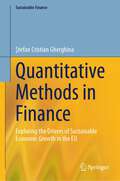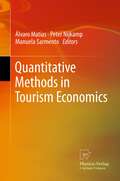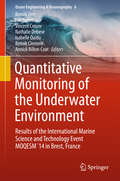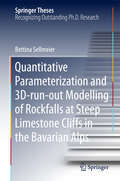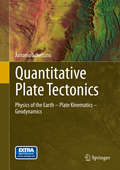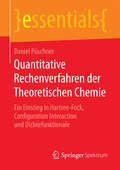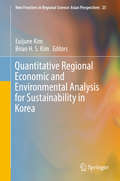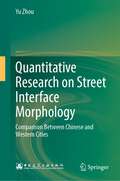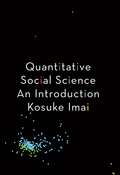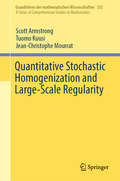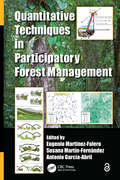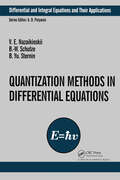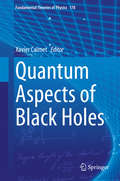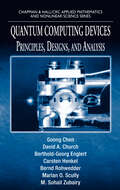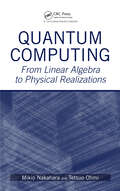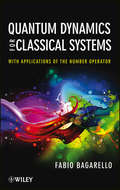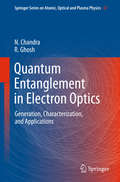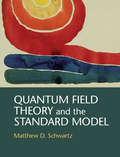- Table View
- List View
Quantitative Methods in Finance: Exploring the Drivers of Sustainable Economic Growth in the EU (Sustainable Finance)
by Ştefan Cristian GherghinaThis book explores certain social and environmental drivers of sustainable economic growth for European Union countries (EU-27) and United Kingdom (UK) in the context of the UN 2030 Agenda for Sustainable Development. The author provides a comprehensive overview of the factors that impact and facilitate sustainable economic growth and discusses the complex set of factors involved in sustainable economic development. Special attention is given to quantitative frameworks and empirical modelling, with the main focus on panel data regression models and vector error correction model approach. Furthermore, the book develops ratings of sustainable economic growth for each of the explored countries, by employing data mining techniques such as principal component analysis. Also, the data envelopment analysis non-parametric methodology towards assessing sustainable economic growth is investigated, as well as the cluster analysis in order to classify the selected nations according to sustainable economic growth. The book appeals to policy-makers and academics targeting to learn more about the characteristics of sustainable economic growth.
Quantitative Methods in Tourism Economics
by Peter Nijkamp Manuela Sarmento Álvaro MatiasTourism economics is partly based on established principles from the economics discipline, but it also incorporates elements from sociology, psychology, organization theory and ecology. It has over the years turned into an appealing multi-disciplinary oriented approach to the understanding of the impacts of leisure time in a modern society, including cultural heritage, sustainable quality of life, and industrial organization of the hospitality industry. The increasing dynamics in the tourist industry and its worldwide effects will continue to attract the attention of both the research and the policy sector in the years to come. Rather than speculating on non-observed facts, there is a clear need for evidence-based research in order to map out the complex dynamics of the tourist industry. The present volume comprises novel studies - mainly of a quantitative-analytical nature - on the supply, demand and contextual aspects of modern tourism. It contains a sound mix of theory, methodology, policy and case studies on various tourism issues in different parts of the world.
Quantitative Methods of Data Analysis for the Physical Sciences and Engineering
by Professor Douglas G. MartinsonThis book provides thorough and comprehensive coverage of most of the new and important quantitative methods of data analysis for graduate students and practitioners. In recent years, data analysis methods have exploded alongside advanced computing power, and it is critical to understand such methods to get the most out of data, and to extract signal from noise. The book excels in explaining difficult concepts through simple explanations and detailed explanatory illustrations. Most unique is the focus on confidence limits for power spectra and their proper interpretation, something rare or completely missing in other books. Likewise, there is a thorough discussion of how to assess uncertainty via use of Expectancy, and the easy to apply and understand Bootstrap method. The book is written so that descriptions of each method are as self-contained as possible. Many examples are presented to clarify interpretations, as are user tips in highlighted boxes.
Quantitative Monitoring of the Underwater Environment
by Luc Jaulin Benoît Zerr Vincent Creuze Nathalie Debese Isabelle Quidu Benoît Clement Annick Billon-CoatThis volume constitutes the results of the International Conference onUnderwater Environment, MOQESM'14, held at "Le Quartz" Conference Center in Brest,France, on October 14-15, 2014, within the framework of the 9thSea Tech Week, International Marine Science andTechnology Event. The objective of MOQESM'14 was to bring together researchers fromboth academia and industry, interested in marine robotics and hydrography withapplication to the coastal environment mapping and underwater infrastructuressurveys. The common thread of the conference is the combination of technicalcontrol, perception, and localization, typically used in robotics, with the methods of mappingand bathymetry. The papers presented in this book focus on two main topics. Firstly, coastal and infrastructure mapping is addressed, focusing notonly on hydrographic systems, but also on positioning systems, bathymetry, and remote sensing. Theproposed methods rely on acoustic sensors such as side scan sonars, multibeam echo sounders,phase-measuring bathymetric sonars, as well as optical systems such as underwater laser scanners. Accurate underwater positioning is also addressed in the case of the use of a singleacoustic beacon, and the latest advances in increasing the vertical precision of Global NavigationSatellite System (GNSS) are also presented. Most of the above mentioned works are closely related to autonomousmarine vehicles. Consequently, the second part of the book describes some works concerning the methodsassociated with such type of vehicles. The selected papers focus on autonomous surface orunderwater vehicles, detailing new approaches for localization, modeling, control, mapping, obstacledetection and avoidance, surfacing, and software development. Some of these works imply acoustics sensing aswell as image processing. Set membership methods are also used in some papers. The applications of the work presented in this book concern inparticular oceanography, monitoring of oil and gas infrastructures, and military field.
Quantitative Parameterization and 3D-run-out Modelling of Rockfalls at Steep Limestone Cliffs in the Bavarian Alps
by Bettina SellmeierThis pioneering work deals with the parameterization of rockfalls in the context of 3D run-out modelling at a study site in the Bavarian Alps. The main objective was to cover not only low-magnitude, high-frequency rockfalls (
Quantitative Plate Tectonics
by Antonio SchettinoThis textbook on plate tectonics is designed for students in geology and geophysics to acquire in-depth knowledge of quantitative methods in plate kinematics and dynamics. Quantitative Plate Tectonics can also be used as a reference book by geoscientists who desire to expand their knowledge beyond their own specialization, or by oil-and-gas professionals and ore deposit specialists that need to investigate the geodynamic context of formation of geologic resources. Finally, this book can be considered as a comprehensive monograph on plate tectonics, which addresses the different quantitative aspects of this broad discipline, which has been traditionally partitioned into separate or quasi-separate branches. Additional material, available at http://extras. springer. com, includes two computer programs for the analysis of marine magnetic anomalies and for plate kinematic modelling, as well as some important geophysical data sets and models. Solutions to the exercises are also included. A unified quantitative description of plate tectonics, combining geological and geophysical perspectives Professional software, manual verification examples and applications are available as additional material Includes detailed calculations, examples, and problem sets per chapter Well illustrated "Dr. Schettino has produced a book covering in a rigorous way the kinematics and dynamics of plate tectonics. The fundamental physics governing geodynamic processes is discussed quantitatively, the relevant equations are clearly derived, and the implications of results are illustrated with examples and problems. The book will repay careful reading not only by postgraduate students in geophysics and geology, but also by any Earth scientist who wishes to acquire a quantitative understanding of plate tectonics. "Giorgio Ranalli, Distinguished Research Professor, Department of Earth Sciences, Carleton university, Ottawa, Canada (author of "Rheology of the Earth", two editions, 1987 and 1995) "This text gives an excellent quantitative presentation of the kinematics and the dynamics of plate tectonics that integrates many aspects of the Earth sciences and provides a powerful model of the dynamic behaviour of the Earth. The geological and geophysical processes involved in elucidating the theory are clearly illustrated through a perfectly balanced level of mathematical and physical concepts including derivation of the relevant equations, examples and problems. The book is intended for advanced undergraduates, graduate students and professional earth scientists requiring an overview of the essential processes of plate tectonics. "Marco Ligi, Senior Researcher, National Research Council of Italy, Istituto di Scienze Marine, Bologna, Italy.
Quantitative Rechenverfahren der Theoretischen Chemie: Ein Einstieg in Hartree-Fock, Configuration Interaction und Dichtefunktionale (essentials)
by Daniel PüschnerDaniel Püschner stellt sowohl grundlegende Methoden der Computerchemie als auch heute genutzte moderne Methoden wie Coupled Cluster und die Dichtefunktionaltheorie vor. Mithilfe der Wellenfunktionstheorie wird in diesem essential gezeigt, wie die Energie eines Systems berechnet werden kann. Anschließend geht der Autor auf die Probleme der behandelten Methoden ein und zeigt, wie diese systematisch behoben werden können. Insbesondere in der Forschung ist die Computerchemie heutzutage nicht mehr wegzudenken. Obwohl die meisten Eigenschaften auch experimentell zugänglich sind, können Ergebnisse aus quantenmechanischen Rechnungen dabei helfen, die experimentellen Ergebnisse zu verstehen und zu interpretieren. Ein grundlegendes Verständnis ist daher auch für Experimentalchemiker unerlässlich, weshalb im Rahmen des Chemiestudiums die Grundlagen der Theoretischen Chemie behandelt werden. Für dieses essential werden Grundkenntnisse in den Bereichen der Mathematik und der Theoretischen Chemie ebenfalls vorausgesetzt.
Quantitative Regional Economic and Environmental Analysis for Sustainability in Korea
by Euijune Kim Brian H. S. KimThis book focuses on the application of newly innovated analytical tools for sustainable development on regional economic and environmental issues in Korea. With a range of case studies, the authors explore a series of theoretical models and empirical methods including spatial CCE Model, multiregional Input-Output and econometric analysis, logit model, contingent valuation method, GIS, sample selection model, machine learning technique, stochastic frontier analysis, and panel analysis. These models and methods are tailored to spatial development issues such as agglomeration, clustering and industrial innovation, human capital and labor market, education and R&D investments and economic resilience for regional economies and unexpected disaster, and natural resources for environmental markets. Quantitative Regional Economic and Environmental Analysis for Sustainability in Korea is of particular interest to policy makers and practitioners, as well as research scholars active in sustainability science.
Quantitative Remote Sensing: Fundamentals and Environmental Applications
by Jay GaoThis book provides comprehensive and in-depth explanations of all topics related to quantitative remote sensing and its applications in terrestrial, biospheric, hydrospheric, and atmospheric studies. It elucidates how to retrieve quantitative information on a wide range of environmental parameters from various remote sensing data at the highest accuracy possible and expounds how different aspects of the target of remote sensing can be quantified using diverse analytical methods and level of accuracy. Written in an easy-to-follow language, logically organized, and with step-by-step examples, the book assists readers to deepen their understanding of the theory and cutting-edge research on quantitative remote sensing. Features Explains how to retrieve quantitative information on a wide range of environmental parameters from various tailored remote sensing data at the highest accuracy possible. Manifests the author's decades of teaching and research in quantitative remote sensing and approaches the subject from both theoretical and pragmatic perspectives, informed by the latest research outcomes. Includes practical and real-life examples to illustrate how the quantitative information on a target can be retrieved from a given type of remote sensing data. Focuses on the latest developments in the field of quantitative remote sensing. Introduces sufficient mathematical concepts to reveal how remotely sensed data are converted to quantitative information while providing quality assurance of the retrieved results. This is a suitable textbook for upper-level undergraduate or postgraduate students and serves as a handy and valuable reference for professionals working in monitoring the environment. By reading this book, readers gain a sound understanding of how to retrieve quantitative information on the environment from diverse remote sensing data using the most appropriate cutting-edge methods and software.
Quantitative Research on Street Interface Morphology: Comparison Between Chinese and Western Cities
by Yu ZhouThis book investigates the historical evolution, regional differences, and quantitative measurement on street interface, which forms the street space and plays a very important role in urban form. Empirical research reveals the street interface in Chinese cities are much more complicated than European and American cities. This book explores the reason and reveals the relationship between street interface and urban form in morphology. By constructing quantitative measurement method on street interface morphology, quantitative parameters can be used in urban planning guidelines in China. Both researchers and students working in architecture, urban design, urban planning and urban studies can benefit from this book.
Quantitative Seismic Interpretation
by Per Avseth Tapan Mukerji Gary MavkoDemonstrating how rock physics can be applied to predict reservoir parameters, such as lithologies and pore fluids, from seismically derived attributes, this volume provides an integrated methodology and practical tools for quantitative interpretation, uncertainty assessment, and characterization of subsurface reservoirs. Including problem sets and a case-study for which seismic and well-log data and Matlab codes are provided on the Internet (http://publishing. cambridge. org/resources/0521816017), the book is intended for students of petroleum geoscience as well as professionals in the field.
Quantitative Social Science: An Introduction
by Kosuke ImaiAn introductory textbook on data analysis and statistics written especially for students in the social sciences and allied fields Quantitative analysis is an increasingly essential skill for social science research, yet students in the social sciences and related areas typically receive little training in it--or if they do, they usually end up in statistics classes that offer few insights into their field. This textbook is a practical introduction to data analysis and statistics written especially for undergraduates and beginning graduate students in the social sciences and allied fields, such as economics, sociology, public policy, and data science. Quantitative Social Science engages directly with empirical analysis, showing students how to analyze data using the R programming language and to interpret the results--it encourages hands-on learning, not paper-and-pencil statistics. More than forty data sets taken directly from leading quantitative social science research illustrate how data analysis can be used to answer important questions about society and human behavior. Proven in the classroom, this one-of-a-kind textbook features numerous additional data analysis exercises and interactive R programming exercises, and also comes with supplementary teaching materials for instructors. Written especially for students in the social sciences and allied fields, including economics, sociology, public policy, and data science Provides hands-on instruction using R programming, not paper-and-pencil statistics Includes more than forty data sets from actual research for students to test their skills on Covers data analysis concepts such as causality, measurement, and prediction, as well as probability and statistical tools Features a wealth of supplementary exercises, including additional data analysis exercises and interactive programming exercises Offers a solid foundation for further study Comes with additional course materials online, including notes, sample code, exercises and problem sets with solutions, and lecture slides
Quantitative Stochastic Homogenization and Large-Scale Regularity (Grundlehren der mathematischen Wissenschaften #352)
by Scott Armstrong Tuomo Kuusi Jean-Christophe MourratThe focus of this book is the large-scale statistical behavior of solutions of divergence-form elliptic equations with random coefficients, which is closely related to the long-time asymptotics of reversible diffusions in random media and other basic models of statistical physics. Of particular interest is the quantification of the rate at which solutions converge to those of the limiting, homogenized equation in the regime of large scale separation, and the description of their fluctuations around this limit. This self-contained presentation gives a complete account of the essential ideas and fundamental results of this new theory of quantitative stochastic homogenization, including the latest research on the topic, and is supplemented with many new results. The book serves as an introduction to the subject for advanced graduate students and researchers working in partial differential equations, statistical physics, probability and related fields, as well as a comprehensive reference for experts in homogenization. Being the first text concerned primarily with stochastic (as opposed to periodic) homogenization and which focuses on quantitative results, its perspective and approach are entirely different from other books in the literature.
Quantitative Techniques in Participatory Forest Management
by Eugenio Martínez-FaleroForest management has evolved from a mercantilist view to a multi-functional one that integrates economic, social, and ecological aspects. However, the issue of sustainability is not yet resolved. Quantitative Techniques in Participatory Forest Management brings together global research in three areas of application: inventory of the forest variables that determine the main environmental indices, description and design of new environmental indices, and the application of sustainability indices for regional implementations. All these quantitative techniques create the basis for the development of scientific methodologies of participatory sustainable forest management.
Quantization Methods in the Theory of Differential Equations (Differential and Integral Equations and Their Applications)
by Vladimir E. Nazaikinskii Boris Yu. Sternin B.-W. SchulzeThis volume presents a systematic and mathematically rigorous exposition of methods for studying linear partial differential equations. It focuses on quantization of the corresponding objects (states, observables and canonical transformations) in the phase space. The quantization of all three types of classical objects is carried out in a unified w
Quantized Detector Networks: The Theory of Observation (Cambridge Monographs on Mathematical Physics)
by George JaroszkiewiczScientists have been debating the meaning of quantum mechanics for over a century. This book for graduate students and researchers gets to the root of the problem; the contextual nature of empirical truth, the laws of observation and how these impact on our understanding of quantum physics. Bridging the gap between non-relativistic quantum mechanics and quantum field theory, this novel approach to quantum mechanics extends the standard formalism to cover the observer and their apparatus. The author demystifies some of the aspects of quantum mechanics that have traditionally been regarded as extraordinary, such as wave-particle duality and quantum superposition, by emphasizing the scientific principles rather than the mathematical modelling involved. Including key experiments and worked examples throughout to encourage the reader to focus on empirically sound concepts, this book avoids metaphysical speculation and also alerts the reader to the use of computer algebra to explore quantum experiments of virtually limitless complexity.
Quantum Aspects of Black Holes (Fundamental Theories of Physics #178)
by Xavier CalmetBeginning with an overview of the theory of black holes by the editor, this book presents a collection of ten chapters by leading physicists dealing with the variety of quantum mechanical and quantum gravitational effects pertinent to black holes. The contributions address topics such as Hawking radiation, the thermodynamics of black holes, the information paradox and firewalls, Monsters, primordial black holes, self-gravitating Bose-Einstein condensates, the formation of small black holes in high energetic collisions of particles, minimal length effects in black holes and small black holes at the Large Hadron Collider. Viewed as a whole the collection provides stimulating reading for researchers and graduate students seeking a summary of the quantum features of black holes.
Quantum Chemical Approach for Organic Ferromagnetic Material Design
by Yuriko Aoki Yuuichi Orimoto Akira ImamuraThis brief provides an overview of theoretical research in organic ferromagnetic material design using quantum chemical approaches based on molecular orbital theory from primary H#65533;ckel to ab initio levels of theory. Most of the content describes the authors' approach to identify simple and efficient guidelines for magnetic design, which have not been described in other books. Individual chapters cover quantum chemistry methods that may be used to find hydrocarbon systems with degenerate non-bonding molecular orbitals that interact with each other, to identify high-spin-preferred systems using an analytical index that allows for simple design of high-spin systems as well as to analyze the effect of high-spin stability through orbital interactions. The extension of these methods to large systems is discussed. This book is a valuable resource for students and researchers who are interested in quantum chemistry related to magnetic property.
Quantum Computing Devices: Principles, Designs, and Analysis
by Goong Chen David A. Church Berthold-Georg Englert Carsten Henkel Bernd Rohwedder Marlan O. Scully M. Suhail ZubairyOne of the first books to thoroughly examine the subject, Quantum Computing Devices: Principles, Designs, and Analysis covers the essential components in the design of a "real" quantum computer. It explores contemporary and important aspects of quantum computation, particularly focusing on the role of quantum electronic devices as quantum gates.
Quantum Computing: From Linear Algebra to Physical Realizations
by Mikio Nakahara Tetsuo OhmiCovering both theory and progressive experiments, Quantum Computing: From Linear Algebra to Physical Realizations explains how and why superposition and entanglement provide the enormous computational power in quantum computing. This self-contained, classroom-tested book is divided into two sections, with the first devoted to the theoretical aspect
Quantum Critical Phenomena of Valence Transition: Heavy Fermion Metals and Related Systems (Springer Tracts in Modern Physics #289)
by Shinji Watanabe Kazumasa MiyakeThis book comprehensively presents an unconventional quantum criticality caused by valence fluctuations, which offers theoretical understanding of unconventional Fermi-liquid properties in cerium- and ytterbium-based heavy fermion metals including CeCu2(Si,Ge)2 and CeRhIn5 under pressure, and quasicrystal β-YbAlB4 and Yb15Al34Au51. The book begins with an introduction to fundamental concepts for heavy fermion systems, valence fluctuation, and quantum phase transition, including self-consistent renormalization group theory. A subsequent chapter is devoted to a comprehensive description of the theory of the unconventional quantum criticality based on a valence transition, featuring explicit temperature dependence of various physical quantities, which allows for comparisons to relevant experiments. Lastly, it discusses how ubiquitous the valence fluctuation is, presenting candidate materials not only in heavy fermions, but also in strongly correlated electrons represented by high-Tc superconductor cuprates. Introductory chapters provide useful materials for learning fundamentals of heavy fermion systems and their theory. Further, experimental topics relevant to valence fluctuations are valuable resources for those who are new to the field to easily catch up with experimental background and facts.
Quantum Dynamics for Classical Systems: With Applications of the Number Operator
by Fabio BagarelloIntroduces number operators with a focus on the relationship between quantum mechanics and social science Mathematics is increasingly applied to classical problems in finance, biology, economics, and elsewhere. Quantum Dynamics for Classical Systems describes how quantum tools—the number operator in particular—can be used to create dynamical systems in which the variables are operator-valued functions and whose results explain the presented model. The book presents mathematical results and their applications to concrete systems and discusses the methods used, results obtained, and techniques developed for the proofs of the results. The central ideas of number operators are illuminated while avoiding excessive technicalities that are unnecessary for understanding and learning the various mathematical applications. The presented dynamical systems address a variety of contexts and offer clear analyses and explanations of concluded results. Additional features in Quantum Dynamics for Classical Systems include: Applications across diverse fields including stock markets and population migration as well as a unique quantum perspective on these classes of models Illustrations of the use of creation and annihilation operators for classical problems Examples of the recent increase in research and literature on the many applications of quantum tools in applied mathematics Clarification on numerous misunderstandings and misnomers while shedding light on new approaches in the field Quantum Dynamics for Classical Systems is an ideal reference for researchers, professionals, and academics in applied mathematics, economics, physics, biology, and sociology. The book is also excellent for courses in dynamical systems, quantum mechanics, and mathematical models.
Quantum Entanglement in Electron Optics
by Rama Ghosh Naresh ChandraThis monograph forms an interdisciplinary study in atomic, molecular, and quantum information (QI) science. Here a reader will find that applications of the tools developed in QI provide new physical insights into electron optics as well as properties of atoms & molecules which, in turn, are useful in studying QI both at fundamental and applied levels. In particular, this book investigates entanglement properties of flying electronic qubits generated in some of the well known processes capable of taking place in an atom or a molecule following the absorption of a photon. Here, one can generate Coulombic or fine-structure entanglement of electronic qubits. The properties of these entanglements differ not only from each other, but also from those when spin of an inner-shell photoelectron is entangled with the polarization of the subsequent fluorescence. Spins of an outer-shell electron and of a residual photoion can have free or bound entanglement in a laboratory.
Quantum Entanglement in Electron Optics: Generation, Characterization, and Applications (Springer Series on Atomic, Optical, and Plasma Physics #67)
by Rama Ghosh Naresh ChandraThis monograph forms an interdisciplinary study in atomic, molecular, and quantum information (QI) science. Here a reader will find that applications of the tools developed in QI provide new physical insights into electron optics as well as properties of atoms & molecules which, in turn, are useful in studying QI both at fundamental and applied levels. In particular, this book investigates entanglement properties of flying electronic qubits generated in some of the well known processes capable of taking place in an atom or a molecule following the absorption of a photon. Here, one can generate Coulombic or fine-structure entanglement of electronic qubits. The properties of these entanglements differ not only from each other, but also from those when spin of an inner-shell photoelectron is entangled with the polarization of the subsequent fluorescence. Spins of an outer-shell electron and of a residual photoion can have free or bound entanglement in a laboratory.
Quantum Field Theory and the Standard Model
by Matthew D. SchwartzProviding a comprehensive introduction to quantum field theory, this textbook covers the development of particle physics from its foundations to the discovery of the Higgs boson. Its combination of clear physical explanations, with direct connections to experimental data, and mathematical rigor make the subject accessible to students with a wide variety of backgrounds and interests. Assuming only an undergraduate-level understanding of quantum mechanics, the book steadily develops the Standard Model and state-of-the-art calculation techniques. It includes multiple derivations of many important results, with modern methods such as effective field theory and the renormalization group playing a prominent role. Numerous worked examples and end-of-chapter problems enable students to reproduce classic results and to master quantum field theory as it is used today. Based on a course taught by the author over many years, this book is ideal for an introductory to advanced quantum field theory sequence or for independent study.
